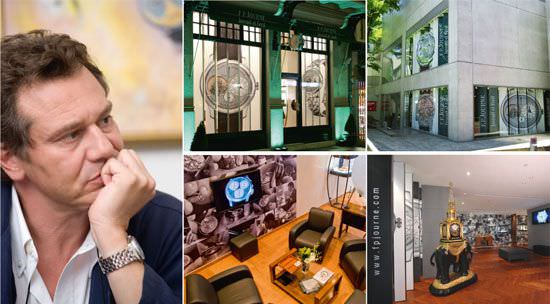How are the independent watch brands faring in light of the current economic crisis? What are the strategies that they have adopted to deal with this slowdown? How have they adapted their production, their product lines and their positioning?
Has the crisis affected or transformed their relationships with retailers? Has the distribution landscape been upset? Has their access to markets become more difficult? Finally, does this economic downturn mark a long-lasting ethical and aesthetic rupture with the preceding period of pomp and splendour?
Europa Star takes a look at these and other questions in this investigation into the current situation. We talked with ten watch brands whose common denominator is that they are independent from the large dominant groups. Aside from this aspect, however, these brands are quite different from each other in terms of price, positioning, history and commercial network. But as we will observe, while the problems they are confronting are by far not the same, some of the challenges they face are indeed similar. This is obvious, for example, when comparing a young ambitious watchmaker—Ladoire—who launched products priced in six figures right during the middle of the crisis, with a solid family business—Raymond Weil—that comes complete with a good global network.
The unspoken: the power of the groups
Everyone whispers it, yet all want to remain anonymous. Faced with the large groups and their power, it is better to remain prudent. But the observation is unanimous. The crisis has drastically highlighted not only the pressure at the production level, of course, but also at the distribution level. For those who do not yet have a distribution network or are in the middle of constructing one, the entry ticket to the retailer has become out of reach.

François-Paul Journe and some of his boutiques (from left to right and top to bottom: Geneva, Tokyo, Paris, Hong Kong).
Because of the plurality, complementarities and the reputation of their bouquet of brands, the groups have locked up large sections of distribution. With the crisis, the situation has become even more dramatic. The pre-crisis period (quite recent even though it may seem a long time ago—a year of strong pressure on distribution, with notably two SIHH shows in one year) saw an explosion of the sell-in. Coerced—although sometimes willing—retailers accumulated high levels of stocks, to the point that in some parts of the world (the USA and the Caribbean, to cite only two examples), “it will take years to lower the stocks,” said one of those we spoke with. And as one of our interviewees, FranÇois-Paul Journe, said ironically, “some brands are going to feel the crisis even two years after it ends”.
Saturation and loss of control
We can easily imagine it. The saturation of the sell-in and the drip by drip moving of the sell-out pave the way for all sorts of practices, which, in general, are harmful to the watch industry as a whole but are brutally felt by the independents: grey market, unauthorized tax-free sales, exaggerated discounts and price slashing, sometimes up to 80 per cent. For young brands that are active in the haut de gamme, the result of this loss of control can be devastating.
By revealing the extent of these practices, the crisis has had a demoralizing effect on some young independent watchmakers. Guillaume Tetu and Renaud de Retz, the two owners of Hautlence, mince no words about the situ-ation. “We have an approach that is too honest for this milieu.” Like others, they have done a “thorough housecleaning” and promise themselves to “not begin again with their heads lowered” especially in Asia “where we cannot control the prices at all.” They are going to start again step by step, but “only with trustworthy partners. There are some out there, but very few in number. When we find them, they are worth their weight in gold.” So, it seems then that everything is not so negative? “No, no,” they add. “We are suffering but this blow is not all bad. It is a very telling period.”
Confidence crisis
What is perhaps more serious, noted by some, is that the economic downturn—with its parade of discounts and unauthorized sales—has brought about a confidence crisis. “There is a rupture with the client,” according to the well-known retailer, Laurent Picciotto, whose words are transmitted to us by Lionel Ladoire. The upturn that preceded the crisis created a serious confusion in terms of values. Everything or nearly everything seemed possible and a number of young brands, devoid of all watchmaking authenti-city but lured by the prospect of high margins, fed this unbridled excess.
As Vianney Halter stated with biting sarcasm in an interview with Business Montres, perhaps the time of “the wedding cake watches with layers of triple tourbillons, time equations, power reserve indicators and reminder screws in the neck and meteorite dials and cases made of onanism masturbarium coated with PVD—the entire ensemble worn elegantly by Cinderella McQuiddick during her first steps on the planet Mars” is finally over. And, “perhaps, we will again speak of real watchmaking. . .” Still, the damage has been done and the end consumer is now suspicious of all products and wants to have a second look at everything.
This confidence crisis, this confusion, is forcing many independents to make an enormous effort to regain their foothold and to clearly distinguish between a pure marketing brand, which flashily envelops a movement purchased in the marketplace and a brand that tries to propose a product that has been authentically designed and developed in-house, often over a long period of time.
The strategies of the independents confronted with the economic crisis: Part 2
The strategies of the independents confronted with the economic crisis: Part 3
The strategies of the independents confronted with the economic crisis: Part 4
Source: Europa Star October-November 2009 Magazine Issue





